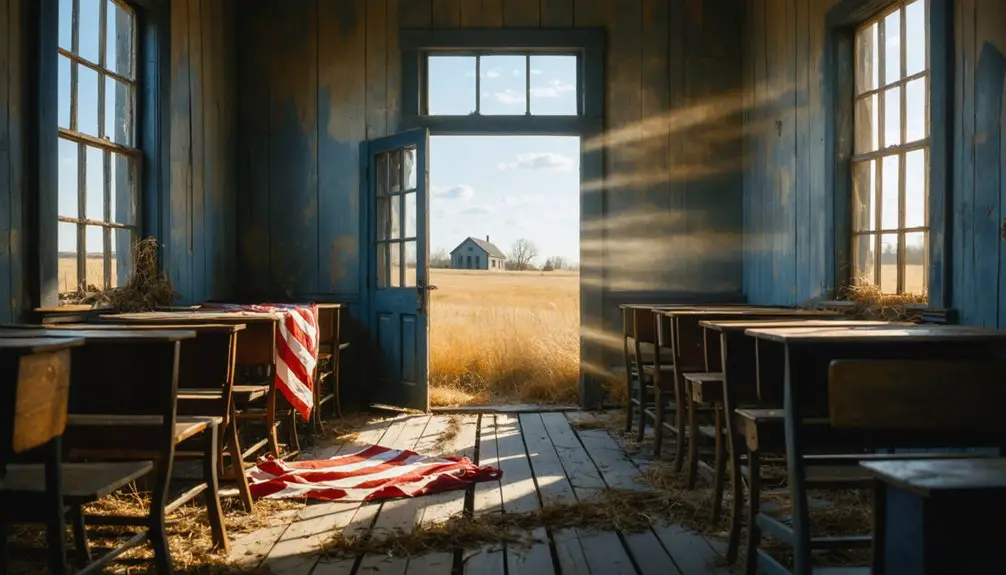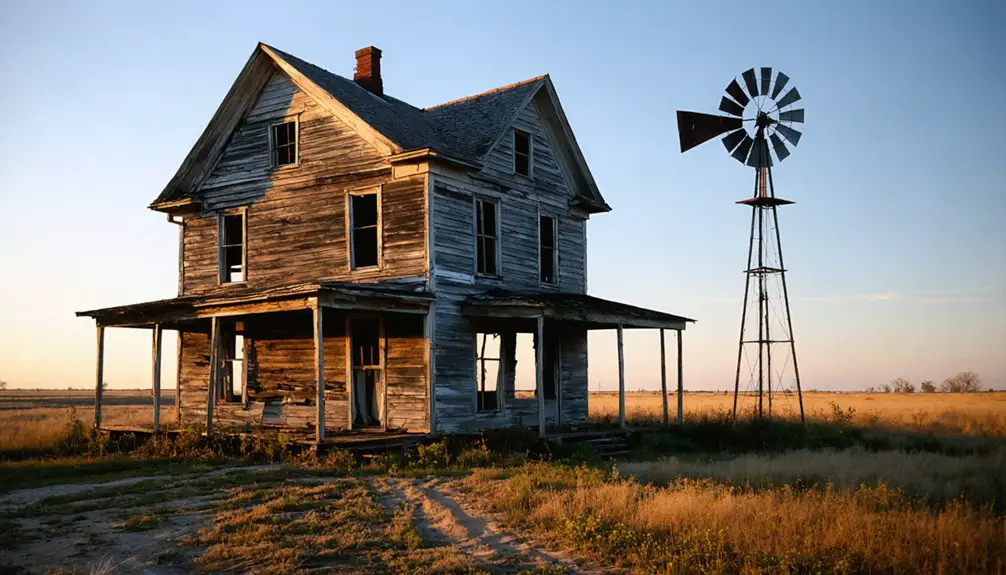You’ll find Alexander’s ghost town roots in Rush County, Kansas, where it began as an 1869 trading post along the Fort Hays-Fort Dodge Military Trail. Under Alexander Harvey’s management from 1872, this Walnut Creek settlement served as a sanctuary for military personnel, hunters, and pioneers. The town flourished with a stockade, lookout tower, and post office by 1874, but economic shifts and bypassed trade routes transformed this once-bustling community into a hallmark of frontier life.
Key Takeaways
- Alexander began as an 1869 trading post along the Fort Hays-Fort Dodge Military Trail, becoming Rush County’s oldest settlement.
- The town featured a fortified stockade with lookout tower, post office, and log schoolhouse serving military personnel and settlers.
- Located strategically on Walnut Creek’s north bank, the site provided timber, water, and natural defenses for frontier activities.
- Economic decline occurred when trade routes bypassed the settlement and lack of railroad connections isolated the community.
- The abandoned school building and preservation efforts through Alexander Majors House Museum maintain the ghost town’s historical legacy.
Trading Post Origins: A Frontier Refuge
The origins of Alexander’s Trading Post trace back to the tumultuous period of 1868-1869, when a Mr. Fink established a fortified outpost along one of Kansas’s essential trading routes – the Fort Hays-Fort Dodge Military Trail.
You’ll find its strategic location was carefully chosen on Walnut Creek’s north bank in Rush County, where it served as a beacon of community resilience during the challenging frontier era.
When Alexander Harvey took ownership in 1872, the log trading post, complete with its protective stockade and lookout tower, became a significant refuge for diverse frontier groups. Like the historic Chouteau Trading Post established in 1825, it became a vital center of commerce and cultural exchange.
Cavalry units under General Custer, freighters, traders, and settlers found safety within its walls. The establishment of a post office in 1874 marked the trading post’s evolution into a permanent settlement.
The post’s reputation as a secure haven against outlaws and hostile forces helped spark the settlement that would eventually become Alexander, Kansas.
Life at Harvey’s Ranch
Life at Harvey’s Ranch centered around the trading post’s daily operations, where you’d find travelers exchanging goods and sharing news while sheltering from the harsh frontier conditions.
You couldn’t miss the sturdy stockade surrounding the ranch, which protected inhabitants from both outlaws and dangerous wildlife that roamed the Kansas plains.
If you were a visitor in those days, you’d witness a bustling community where traders, freighters, and settlers gathered to conduct business while remaining vigilant against the various threats of frontier life. Located along the Fort Hays-Fort Dodge Trail, the ranch provided a crucial stopping point for military personnel and civilian travelers alike.
The ranch’s success drew from Harvey’s expertise as a practical surveyor, which helped him strategically position and develop the property.
Daily Ranch Operations
Operating from its strategic position along the Fort Hays-Fort Dodge Military Trail, Harvey’s Ranch bustled with daily activities that served a diverse array of frontier travelers.
You’d find ranch chores beginning at sunrise, as workers prepared supplies for incoming cavalry units, freighters, and settlers. Animal husbandry played an essential role in maintaining livestock for both the ranch and weary travelers. Much like the Quaker missionaries who established settlements in Kansas Territory, the ranch provided crucial support to those in need. The ranch utilized rotational grazing methods to maintain healthy pastures for their livestock.
As the day progressed, you’d witness a constant flow of visitors seeking refuge and supplies. The ranch coordinated vital services, from providing meals and lodging to facilitating trade between travelers and local communities.
Managing deliveries along the trail kept the operation running smoothly, while supporting surveyors, hunters, and trappers with their specialized needs. Through these daily operations, Harvey’s Ranch became an indispensable hub of frontier life.
Trading Post Defense Measures
Situated along the Fort Hays-Fort Dodge Military Trail in 1868, Harvey’s Ranch incorporated robust defense measures to protect its diverse array of frontier visitors.
The trading post’s defensive architecture featured a sturdy log construction using timber harvested from nearby Walnut Creek, with a strategic stockade design encircling the perimeter.
You’d have found comfort in the post’s thorough security measures, which included an elevated lookout position to spot potential threats.
This vigilant approach protected traders, cavalry units, and travelers from various dangers, including hostile encounters with renegade Whites and Indians.
The presence of Alexander Harvey, a former soldier in Custer’s 6th Cavalry, enhanced the post’s military connections and defensive capabilities, while regular cavalry patrols along the trail provided additional security.
The site later evolved into the town of Alexander, which is now home to the Alexander Wind Farm that generates nearly 50 megawatts of power.
Living Among Frontier Dangers
Though daily survival presented constant challenges at Harvey’s Ranch, the trading post’s strategic location along Walnut Creek provided crucial resources for its diverse inhabitants.
You’d have faced multiple frontier threats daily – from hostile Native Americans defending their territories to dangerous prairie wildlife and renegade Whites prowling the isolated landscape.
Your community’s resilience emerged through shared defense strategies, including the protective stockade and vigilant lookout towers.
In your daily life, you’d join other settlers, military personnel, and traders in significant community functions at the log schoolhouse, where education, prayer services, and public meetings strengthened your bonds.
The arrival of mail via stagecoach maintained your lifeline to the outside world, while agriculture, hunting, and trading sustained your frontier existence.
Like many settlers of the era, families would live in sod houses while establishing their homesteads and working to secure permanent dwellings.
Early pioneers like Perry and Cleveland were among the first to establish cattle ranches in the region, contributing to the area’s agricultural development.
Early Settlers and Community Formation
You’ll find the roots of Alexander in an 1869 trading post established by Mr. Fink along Walnut Creek’s north bank.
The trading post, fortified with a log stockade and lookout tower, served as protection against outlaws and Indian attacks while supporting early commerce in the region.
When J.C. Young’s family arrived from Pennsylvania in 1872, followed by Alexander Harvey who took over the trading post that same year, these pioneering settlers laid the foundation for what would become the oldest settlement in Rush County.
Like the first post office established in Doniphan in 1855, Alexander’s trading post became a vital community center for the developing settlement.
Trading Post Origins
During the tumultuous period of westward expansion in 1868-1869, Alexander Harvey, a former soldier in General Custer’s 6th Cavalry, established an important trading post known as “Harvey’s Ranch” along the Fort Hays-Fort Dodge Military Trail.
The trading post’s architecture featured a sturdy stockade, built to protect against outlaws and hostile encounters on the untamed prairie. While frontier commerce had begun at this location earlier under Mr. Fink and Johnny Quinn, it was Harvey who transformed the site into a significant hub.
You’ll find the trading post served as more than just a commercial center – it became a sanctuary for military personnel, hunters, and travelers.
Positioned strategically on Walnut Creek’s north bank, it offered essential supplies and shelter to those traversing the challenging frontier landscape.
First Families Arrive
When the first pioneer families ventured into the territory surrounding Alexander in the early 1870s, William Basham had already established himself as the area’s earliest settler by 1870.
The promise of freedom and opportunity drew families like the J.C. Youngs from Pennsylvania in 1872, while P.C. Dixon had already filed the first land claim near Walnut Creek.
Settler motivations varied, with some seeking escape from persecution.
You’ll find this especially true of the Volga German families – the Herrmans, Schaffers, Bolligs, and Kreutzers – who fled Russia’s intolerant conditions.
These determined families initially lived in dugout shelters before building proper framed houses, adapting their traditional limestone building techniques from Russia.
Family dynamics centered around the log schoolhouse, which served as both an educational facility and community gathering place.
The Strategic Walnut Creek Location

Situated strategically on the north bank of Walnut Creek, Alexander’s original settlement location proved crucial for both survival and commerce in the late 1860s.
Alexander’s strategic settlement along Walnut Creek’s north bank became a vital frontier outpost, sustaining life and trade throughout the 1860s.
You’ll find this strategic location served as a natural crossing point along the Fort Hays-Fort Dodge Military Trail, where timber-rich terrain provided building materials and natural defenses against threats.
The creek’s waters attracted wildlife like buffalo and deer, while the surrounding landscape offered protection for settlers and travelers alike.
You’d have seen how this essential water source enabled the trading post’s establishment in 1869, first under Mr. Fink’s management and later as Harvey’s Ranch.
The site’s positioning made it an ideal hub for cavalry units, freighters, and traders, who’d stop here for supplies, communication, and refuge while traversing the challenging frontier trails.
Mail Service and Communication Routes
As Alexander grew from a trading post into a settlement, the establishment of its post office on February 13, 1874, marked an essential milestone in the town’s development.
With Alexander Harvey as the first postmaster, you’d find the town’s communication infrastructure centered around the Fort Hays-Fort Dodge Trail, a significant corridor for stagecoach mail routes.
Your mail delivery would arrive by train at the “end of line depot” before transferring to stagecoaches that braved the challenging terrain.
These routes weren’t just about letters – they represented your lifeline to the outside world.
While protecting mail from outlaws required fortified trading posts with stockades, the arrival of the Kansas Pacific Railroad eventually transformed delivery methods.
Even today, as a ghost town, Alexander maintains its post office, preserving a thread of its communication heritage.
Education and Civic Development

Though Alexander Harvey began as a school teacher before his ventures into politics and ranching, his influence set the tone for education’s crucial role in the community’s development.
You’ll find this education legacy most prominently displayed in the 1916 construction of the town’s red brick schoolhouse, which later expanded to include an auditorium by 1930.
The school wasn’t just about learning – it became the heart of Alexander’s civic identity, hosting community events and serving as a cultural hub.
When the high school closed in 1966, with students redirecting to La Crosse USD 395, it marked a turning point in the town’s decline.
Today, the abandoned three-story building stands along K-96 highway, a monument to Alexander’s former vibrancy and the central role education played in shaping this prairie community.
From Bustling Post to Ghost Town Status
Founded in 1869 as a humble trading post near Walnut Creek, Alexander’s journey from frontier outpost to ghost town spans over a century of dramatic change.
The town’s cultural significance peaked when it served as Rush County’s oldest settlement, with roughly 70 residents during its most prosperous era.
You’ll find the economic shifts that led to Alexander’s decline reflected in these key developments:
- Shifting trade routes and new transportation methods bypassed the once-vital settlement
- Loss of military and civilian traffic diminished the trading post’s economic viability
- Absence of railroad connections left Alexander isolated while nearby towns flourished
- Gradual exodus of residents to more prosperous communities sealed the town’s fate
Today, few physical remnants mark where this frontier community once thrived along Walnut Creek.
Historical Legacy and Preservation

While Alexander’s physical structures have largely vanished, dedicated preservation efforts keep the town’s frontier legacy alive.
You’ll find the town’s cultural heritage preserved through the Alexander Majors House Museum, which opened in 1984 after 40 years of careful restoration by Majors’s great-granddaughter. The museum now partners with the John Wornall House to protect these essential 19th-century landmarks.
The preservation challenges facing Alexander mirror those of many Kansas ghost towns, where original structures like Harvey’s Ranch and the trading post no longer stand.
Yet the town’s significance as a key waypoint for settlers, cavalry, and traders lives on through educational programs and historical records. The National Register listing of related sites guarantees that Alexander’s frontier story won’t be forgotten.
Modern Day Alexander: A Living Ghost Town
Despite its classification as a ghost town, Alexander maintains a small but resilient population of older settlers and families who’ve chosen to stay connected to their rural roots.
Today, you’ll find a complex portrait of community nostalgia mixed with agricultural decline, where functioning grain silos stand alongside deteriorating buildings.
- Many original structures show layers of history through peeling wallpaper and aging infrastructure
- Active farming continues, though mechanization has reduced the need for local labor
- Residents maintain deep ties to their ancestral lands while adapting to changed circumstances
- Agricultural facilities like silos and propane tanks remain operational, serving the surrounding farmland
The town balances its ghost town status with ongoing habitation, creating a unique dynamic where past and present intertwine across the rural Kansas landscape.
Frequently Asked Questions
What Was the Population of Alexander During Its Peak Years?
You’d think this town was once bustling, but historical demographics show Alexander’s peak population was just 202 residents in 1930, with numbers steadily declining through the decades that followed.
Are There Any Remaining Original Buildings From the Trading Post Era?
You won’t find any original architecture from the trading post era standing today. Despite historical preservation efforts, all that remains is a commemorative marker on Alexander’s west edge marking the site.
What Local Native American Tribes Interacted With Alexander’s Trading Post?
When the chips were down, you’d find the Kiowa, Comanche, and Arapaho tribes actively trading at Alexander’s post, with occasional Cheyenne interaction. These Plains tribes shaped the post’s bustling commerce and cultural exchange.
Did Alexander Ever Have a Railroad Connection or Depot?
You’ll find that Alexander’s railroad history included a direct connection when the town relocated near the Santa Fe line in 1886, though records don’t explicitly confirm if a depot existed there.
What Businesses and Stores Operated in Alexander During Its Heyday?
Like a drive-through frontier mall, you’d find Harvey’s Ranch trading post serving as the commercial hub, alongside a general store, blacksmith shops, and wagon repair facilities supporting freighters.
References
- https://legendsofkansas.com/alexander/
- https://www.legendsofamerica.com/parkerville-kansas/
- https://www.youtube.com/watch?v=OyBXD18P_j4
- https://legendsofkansas.com/kansas-ghost-town-list/
- https://www.legendsofamerica.com/ks-ghosttowns/
- https://legendsofkansas.com/trading-post-kansas/
- https://rushcounty.org/history_alexander.html
- https://www.legendsofamerica.com/fort-kanses/
- https://www.youtube.com/watch?v=5AmcGumPdNQ
- http://www.ksgenweb.org/archives/1918ks/bioh/harveyjm.html



